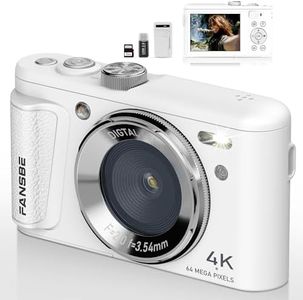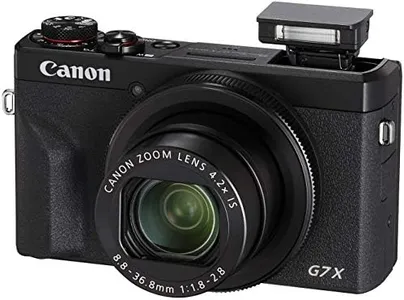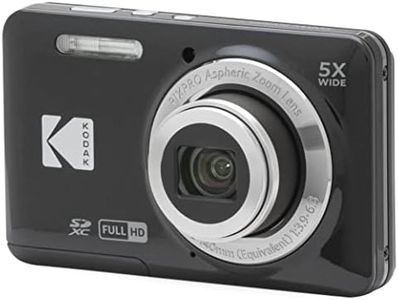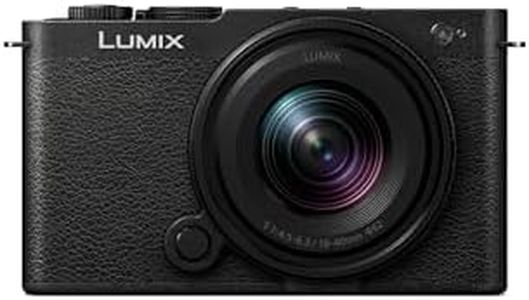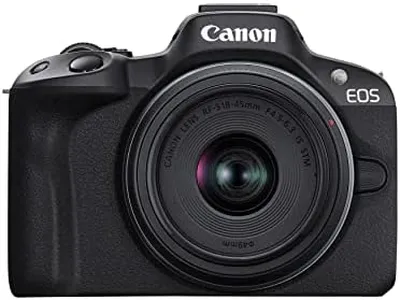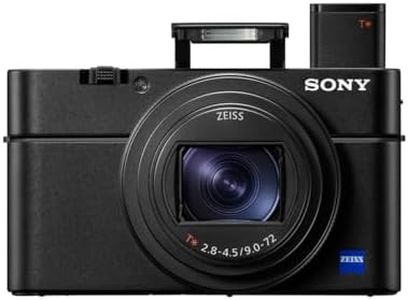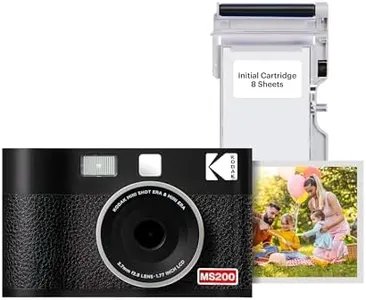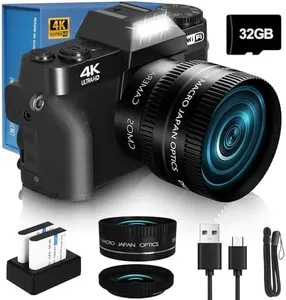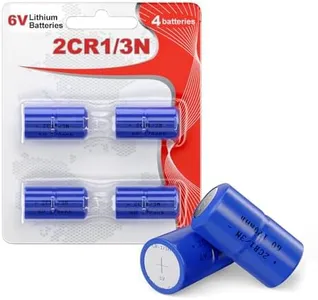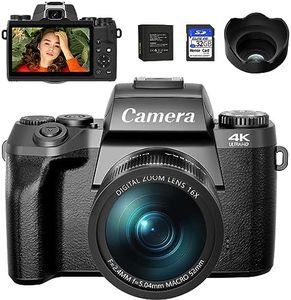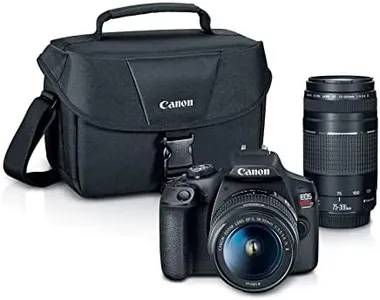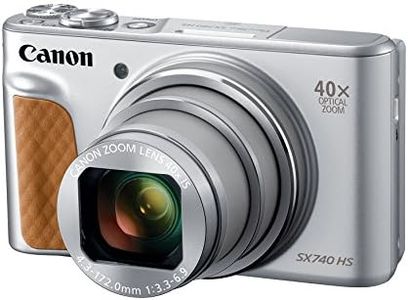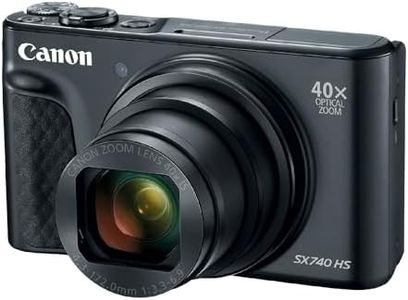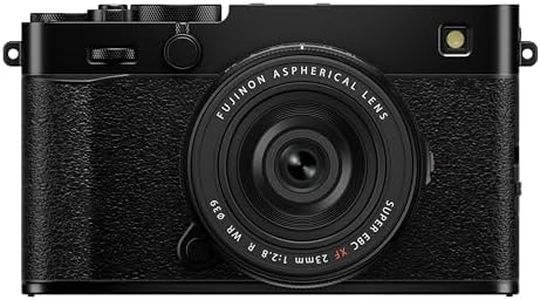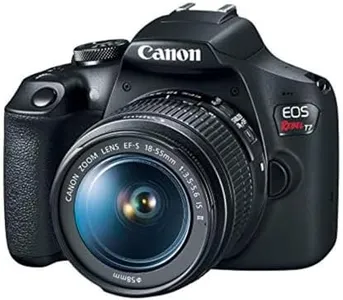10 Best Digital Cameras 2025 in the United States
Our technology thoroughly searches through the online shopping world, reviewing hundreds of sites. We then process and analyze this information, updating in real-time to bring you the latest top-rated products. This way, you always get the best and most current options available.

Our Top Picks
Winner
Canon PowerShot G7 X Mark III Digital Camera (Black)
Most important from
943 reviews
The Canon PowerShot G7X Mark III is a compact digital camera that packs a punch, making it an excellent choice for both photography and videography enthusiasts. With a 20.1 Megapixel stacked CMOS sensor and DIGIC 8 image processor, it delivers high-quality images with impressive detail. The 4.2x optical zoom lens (24-100mm f/1.8-2.8) offers versatility for capturing a range of subjects, from wide landscapes to close-up portraits, while the optical image stabilization helps keep your shots steady, reducing blur during handheld shooting.
For those interested in video, the G7X Mark III supports 4K video recording at 30 frames per second, along with full HD at 120 frames per second for capturing slow-motion footage. This feature is particularly appealing for content creators and vloggers. Additionally, it can easily be used as a high-quality webcam, which is a nice bonus for live streaming.
However, there are some limitations to consider. The autofocus system relies on contrast detection, which may not be as fast or reliable as phase-detection autofocus found in higher-end models, especially in low light conditions. The battery life, while decent, may not last through extended shooting sessions, and an extra battery might be necessary for long days out. Also, it has a single SD card slot, which could be a drawback for users requiring more storage flexibility.
In terms of connectivity, the G7X Mark III includes Wi-Fi and NFC, allowing for easy sharing of photos and videos directly to your devices. The camera's build quality feels solid, but its compact size may not appeal to everyone, especially those who prefer a more robust feel.
The Canon PowerShot G7X Mark III is ideal for travelers, vloggers, and casual photographers who want a portable and powerful camera. While it has a few drawbacks, its strengths in image quality, video capabilities, and user-friendly features make it a strong contender in the compact camera category.
Most important from
943 reviews
KODAK PIXPRO FZ55-BK 16MP CMOS Sensor Digital Camera 5X Optical Zoom 28mm Wide Angle 1080P Full HD Video 2.7" LCD Vlogging Camera (Black)
Most important from
4950 reviews
The KODAK PIXPRO FZ55-BK is a compact digital camera that offers essential features for casual photographers. Its 16 MP CMOS sensor and 5X optical zoom with a 28mm wide-angle lens make it suitable for capturing everyday moments with a reasonable level of detail. The camera's ability to record 1080P Full HD video makes it a decent option for vlogging or personal video recording, although it lacks advanced audio recording capabilities, only having a built-in mono microphone.
One of its strengths is its lightweight and portable nature, weighing just 3.68 ounces, making it easy to carry around for spontaneous photography. Additionally, the camera supports SD cards up to 512GB, which provides ample storage for photos and videos. The 2.7-inch LCD screen offers basic viewing of images and video, although its resolution is relatively low, which might affect the clarity of playback and menu navigation.
It uses a contrast detection autofocus system which is generally slower and less accurate in low-light situations compared to phase detection systems. The camera's ISO range, expandable up to 12800, allows some flexibility in various lighting conditions, but the lack of advanced noise reduction may impact image quality at higher ISO settings.
The build quality is adequate for its price range, but it is not water-resistant, which may limit its use in certain environments. Battery life is powered by a rechargeable Li-Ion battery. Connectivity is limited to USB, focusing on direct data transfer rather than wireless options, which could be a drawback for those looking to share photos instantly. It has digital image stabilization, which helps reduce blur but might not match the effectiveness of optical stabilization systems.
This camera primarily suits beginners or those seeking a simple point-and-shoot experience without the need for advanced control or high-end features.
Most important from
4950 reviews
Panasonic LUMIX S9 Full-Frame Mirrorless Camera with S 18-40mm F4.5-6.3 Lens, Compact, Lightweight Body, Perfect for Social Media and Travel, Cameras for Photography, DC-S9NK
Most important from
77 reviews
The Panasonic LUMIX S9 is a full-frame mirrorless camera designed to deliver high-quality photos and video, making it a great fit for travelers and social media enthusiasts. Its 24.2-megapixel full-frame sensor captures detailed images, even in low light, and the included 18-40mm lens offers a versatile wide-angle zoom, suitable for everyday shooting. The autofocus system is advanced, featuring 255 focus points and Depth From Defocus technology, which helps keep your subjects sharp with ease. Optical image stabilization supports steady shots, useful when shooting handheld or in less bright conditions. Video capabilities include 4K resolution at 60 frames per second, making it strong for high-resolution video recording.
The camera is fairly compact and lightweight for a full-frame model, at about 2.43 pounds, so it’s convenient to carry around during travel. Controls are user-friendly with a 3-inch touch LCD screen, and wireless connectivity via Wi-Fi and Bluetooth allows quick transfer of photos to your smartphone. However, the lens aperture range (f/4.5-6.3) is relatively narrow, which might limit performance in very low light or when seeking a shallow depth of field. Also, the camera lacks a built-in flash and is not water-resistant, so extra care is needed in some shooting conditions. While it offers a rich set of advanced features, beginners might face a slight learning curve.
The LUMIX S9 strikes a good balance between professional-level image quality and portability, making it especially suited for users who want an all-around camera for vibrant photos and videos on the go.
